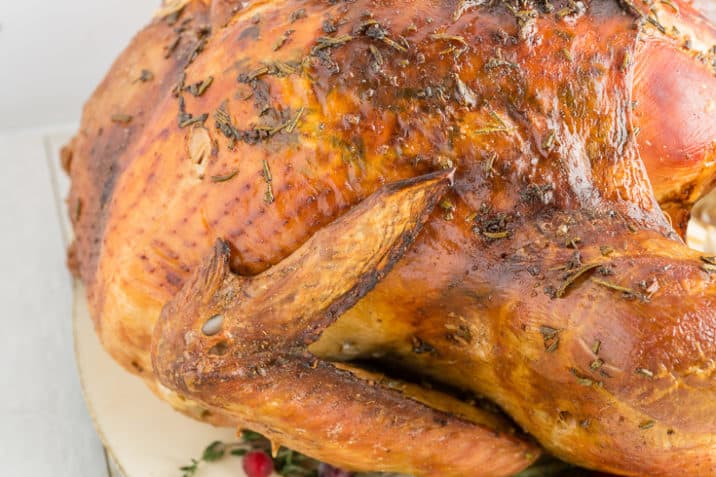Dry brining is a simple and effective technique for getting a tender, juicy turkey with crispy skin and amazing flavor. It involves rubbing salt and seasonings all over the turkey, then letting it rest uncovered in the fridge for 1-3 days before roasting. But should your dry brined turkey be covered or uncovered during the brining time? Here’s what you need to know.
Why Dry Brine a Turkey?
Before answering the covered vs uncovered question let’s first look at why dry brining delivers the best turkey
-
It seasons the meat thoroughly and enhances flavor The salt penetrates deep into the meat.
-
It helps the turkey retain moisture during roasting so the meat stays juicy.
-
It results in ultra crispy skin as moisture gets drawn out then the skin dries,
-
It’s easier than wet brining – no giant buckets required!
Should You Cover or Uncover a Dry Brined Turkey?
Keep your dry brined turkey uncovered in the fridge during the entire process. Here’s why this is important:
-
Uncovered drying time allows the skin to further dehydrate. This leads to crisper skin when roasted.
-
Any covering or wrapping would prevent the skin from drying out optimally.
-
You want the salt and seasoning mix to remain on the surface and not get rubbed off.
-
Covering can create an environment for bacteria growth. An uncovered bird stays safer.
So resist the urge to loosely cover with plastic wrap or tent with foil. For food safety and the best texture, an uncovered turkey is ideal.
How Long to Dry Brine and Uncover
-
Plan on 1-3 days of dry brining time. The longer, the better.
-
Figure 1 hour of uncovered time per 1 lb of turkey. A 12 lb turkey needs 12 hours minimum.
-
For optimal crispy skin, do at least 6-12 hours uncovered at the end.
-
3 full days uncovered is ideal but 1-2 days will still work if you’re short on time.
Dry Brining Steps
Follow these simple steps for a flavorful, juicy turkey with crispy skin:
-
Pat turkey completely dry and remove giblets.
-
Make a salt, herb and spice mixture. Use 2-2 1⁄2 tsp Diamond Crystal kosher salt per lb of turkey.
-
Rub the mixture all over the turkey, including the cavity. Get into every crevice.
-
Place turkey on a rack over a rimmed baking sheet. Refrigerate uncovered for 1-3 days.
-
Roast turkey as desired, basting with butter for extra crispy skin.
-
Let rest 30 minutes before slicing.
Frequently Asked Questions
Should I rinse off the salt after dry brining?
No. Washing off the salt mixture will ruin the crispy skin. Roast it directly after brining.
What about food safety with an uncovered bird?
As long as your fridge is below 40°F, it’s completely safe for the full 1-3 day timeframe.
Can I stuff the turkey before dry brining?
No, only stuff it right before roasting so the stuffing doesn’t absorb too much salt.
Should I brine a kosher turkey?
No, kosher turkeys are already salted – no need to dry brine.
What about self-basting or enhanced turkeys?
Avoid those, as they have been pre-treated with a salt solution already.
For the juiciest, tastiest roast turkey with crispy, bronzed skin, dry brining uncovered is the way to go. Let that bird air out in the fridge before roasting!

How to Make a Traditional Brine
Not convinced by the dry-brining argument? No problem. Heres how to do a traditional brine.
First, make sure there is room in the fridge for a container big enough to hold your turkey. This is the standard way to brine a turkey. You could also fill up some empty two-liter soda bottles with water until they are three quarters full, then freeze them without the lids on. Once theyre completely frozen, seal the bottles with their lids. Next, fill a large cooler or plastic basin with the prescribed amount of tap water. Add the salt, and stir until dissolved. Submerge your fully defrosted turkey in the brine solution, and refrigerate for 12 to 18 hours. You could also put the brining basin somewhere cool in your house and add the frozen soda bottles. Every few hours, remove one and add a new one to keep the water below 40°F (4°C).
After 12 to 18 hours, remove the turkey, dry carefully with paper towels, and roast.
For skin that is crispier, brine your turkey a few days ahead of time. Then, leave it in the fridge uncovered for at least one night and up to two nights on a rack set in a rimmed baking sheet to air-dry.
It’s not the amount of salt to the size of the turkey that matters when making a brine; it’s the amount of salt to the amount of water. You’ll be fine as long as your brine solution has about 6% salt by weight, which is about 1 1/4 cups of kosher salt per gallon, and your turkey is submerged.
Feel free to use these rough guidelines to figure out how much water and salt you’ll need for different turkey sizes:
Traditional Versus Dry Brine—Which Is Better?
I vastly prefer dry brining. A traditional brine will add moisture to your turkey, but most of that moisture is water, which makes the turkey taste watered down. A dry brine, on the other hand, helps the turkey keep its natural moisture without adding any extra water. This makes the flavors stronger.
Adding baking powder to a dry brine can also improve your turkey skin. The baking powder breaks down some proteins in the skin, which helps it crisp and brown faster. It also mixes with the turkey juices to make tiny bubbles that give the skin more surface area and crunch as it roasts.
